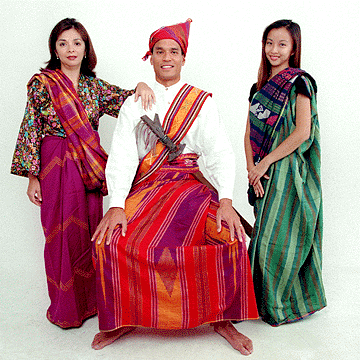
By George F. Lee, Star-Bulletin
Jeannette Thommes, left, Andrew Montemayor and
Rhea Go-Thommes are draped in traditional Filipino textiles
for the Pasko! celebration.

But, legitimately, Christmas really involves only two days, the eve and the day.
In the Philippines, they have us beat. Pasko, the Filipino Christmas celebration lasts a long three weeks. starting 14 days before Christmas Day and continuing through the Feast of Three Kings Jan. 6.
The public will have their chance to join in the celebration Sunday at the Honolulu Academy of Arts, with Pasko!
The academy will be dressed in parol - the star-shaped paper lanterns that adorn Filipino homes -for the 8th annual event. Featured will be arts and craft sales and demonstrations, Filipino food, music and dance focusing on Mindanao, the southern region of the Philippines that is home to Muslim Filipinos and indigenous tribes.
Highlights of the event include kulintang, or gong music, performed by Danongan Kalanduyan, who has performed at the Smithsonian Institution and Kennedy Center and international festivals; and a play based on the traditional Philippines Panunuluyan Christmas procession, directed by Chris Millado, whose work "peregriNASYON" is being staged by Kumu Kahua.
There will be demonstrations of the Philippines martial art kali-escrima, a costume parade, folk tales and an exhibition and sale of authentic tribal textiles from the collection of Ruudje Laarhoven, who holds a doctorate in Southeast Asian textiles.
Laarhoven, a member of the Filipino Association of University Women helping to sponsor Pasko!, said few Filipinos in Hawaii are aware of the intricate textiles created by women in the Sulu region in Western Mindanao, who have more in common with their Borneo neighbors than their urbanized countrymen.
"There are women here who have collected a few textiles, but I don't know of a single Filipina (in Hawaii) who knows much about them or knows how to make them," Laarhoven said.
An anthropologist who studied and taught in the Philippines, she said that she was amazed by the patterns the weavers have committed to memory.
"It's a very mathematical thing and it's all in their heads," she said. "These women would be looking after their sweet potatoes and working the fields with a kid hanging in a sling on their backs, then they'd come home and do this intricate weaving."
Many of these textiles were so intricate, that women could produce only one inch in an eight-hour day on portable back-strap looms that literally involve using one's back to control the threads.
Like other indigenous art forms, the weaving skills are being lost to a younger generation needing to work outside the home to earn a living. But Laarhoven says that the Philippines government has taken an interest in preserving the form and co-ops have been formed to encourage women and pay them enough to work on their weaving full-time.
Although the tribal women are not in the dark about the availability of commercial fabrics, Laarhoven said it is pride in their work that will keep the art of weaving alive.
"Weaving is the right thing to do for their families. They won't wear these beautiful textiles in the fields but they will provide them for weddings, funerals, births, celebrations.
"Everybody buys fabric," Laarhoven said. "But for those occasions they'd never consider using cloth made in a factory."